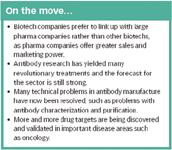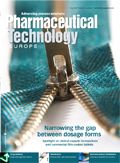Therapeutic antibodies: the next generation
Pharmaceutical Technology Europe
The identification of an increasing number of drug targets coupled with advances in manufacturing technology could lead to many more blockbuster therapeutic antibodies.
Arid development pipelines and the maturation of therapeutic antibody products in recent years have caused many companies operating in this sector to look for new ways to sustain growth. Although research continues in follow-on biologics and novel methods of antibody drug delivery, it will be some time before these innovations translate into revenues. As such, partnerships are the perfect solution for many firms seeking to secure a healthy future.

Susan Aldridge
One example is the recent announcement of a merger between antibody discovery company Affitech (Norway) and therapeutic antibody manufacturer Pharmexa (Denmark). Affitech's phagemid antibody display technology, licensed from the German Cancer Research Centre, makes fully human antibodies against some interesting new targets in cancer and other disease areas. The deal with Pharmexa will provide the company with the development infrastructure to begin commercializing these products. Affitech A/S, as the new company will be known, will focus on the discovery and development of antibodies against challenging targets, such as G-protein coupled receptors (GPCRs) and cancer stem cell antigens, as well as looking for new and improved versions of existing therapeutic antibody products.
A question of strategy
An inter-biotech merger is often the less preferred strategy for those seeking suitable partners as many biotechs prefer to link up with large pharmaceutical companies that can offer greater sales, marketing power and experience. Examples of deals between antibody manufacturing biotech firms and Big Pharma include the late 2006 acquisition of UK-based Domantis by GlaxoSmithKline (GSK). Widely regarded as the pioneer of 'next generation' therapeutic antibodies, and founded as a spin-off from the work of Sir Greg Winter of the Laboratory of Molecular Biology in Cambridge (UK), Domantis was made part of GSK's Centre of Excellence for Drug Discovery. Winter's first breakthrough, in 1986, came when he made the shift from the original mouse-derived monoclonal antibodies, which were not really suitable for clinical application, to humanized versions, which are. However, these large molecules could only be administered by injection or infusion; the research that led to the founding of Domantis involved tailoring the molecules to produce the smallest functional therapeutic binding unit. Through Domantis's research efforts, these domain antibodies can now be delivered by inhalation or topically and even, potentially, orally.
At about the same time, Cambridge Antibody Technology (CAT) (as with Domantis; also a Medical Research Council spin-off) was bought by AstraZeneca. CAT is famous for developing Humira; the first fully human antibody to be commercialized. This company is now known as MedImmune Cambridge.
In search of a blockbuster
Big Pharma's interest in acquiring therapeutic antibodies — either by buying up companies or in-licensing candidate molecules — has grown as the sector has come of age during the last 10 years. In fact, some antibodies have now reached blockbuster status. US-based biotech firm Genentech, in particular, boasts several such blockbuster-level antibodies in the form of Her-2 receptor antagonist Herceptin (trastuzumab), anti-angiogenesis agents Avastin (bevacizumab) and Lucentis (ranibizumab), and B-cell therapy Rituxan (rituximab), which are indicated for various cancers, retinal disease and inflammatory conditions. Meanwhile, US firms Centocor and Abbott have also enjoyed success in this area with their antibodies Remicade (rituximab; indicated for the treatment of leukaemia) and Humira (adalimumab; indicated for the treatment of rheumatoid arthritis), respectively.
Although antibody R&D has already yielded some revolutionizing treatments for oncological, inflammatory and ocular conditions, sales forecasts for currently marketed and pipeline therapeutics are still strong. According to Mario Brkulj, Senior PR Manager at antibody manufacturer MorphoSys (Germany), the therapeutic antibody market was worth $26 billion in 2008 and this is likely to double by 2013.

On the move...
Manufacturing has come a long way
Thanks to developments in manufacturing methods and cell lines used to develop antibodies, many problems that once plagued antibody manufacturers, such as antibody characterization, manufacturing capacity and purification, have largely been resolved. The products themselves are more advanced and can now be successfully developed from fully human, rather than animal, cell lines; a requirement that is increasingly being demanded by regulatory agencies. These next generation antibodies have improved clinical safety and better physicochemical and clinical properties than the 'old' monoclonals. Expression systems have improved so manufacturing yields are up and, with the advent of new chromatography systems and the introduction of disposables for speed and quality, there have been many improvements in downstream processing too. The regulators now seem, on the whole, more comfortable with this class of therapeutics.
This class of drugs is, however, not without its horror stories. One such case to hit the headlines was in March 2006 when Phase I testing of an experimental biologic, TGN 1412, caused the death of three young volunteers in the UK.
What's in the pipeline?
Nonetheless, research continues and, in the wake of the Human Genome Project, which provided many new genes for researchers to study, increasing numbers of drug targets are being discovered and, more importantly, validated in disease areas such as oncology, osteoporosis and inflammation. Couple this with new antibody discovery technologies and there is the potential for many more blockbusters. To name just one example, Affitech's compound R84, which is being codeveloped with Peregrine Pharmaceuticals (CA, USA), is a powerful inhibitor of angiogenesis that could, one day, rival Genentech's cash cow Avastin.
Long-standing German antibody manufacturer MorphoSys also has a number of promising candidates on the horizon. Unlike many biotechs, MorphoSys has retained its independence through an established deal with Novartis, and various agreements with other large pharma companies, such as Merck and Pfizer, have secured a healthy flow of cash for continued research and innovation. Using its patented HuCAL (Human Combinatorial Antibody Library) technology — an automatic and rapid tool for the production of optimized and fully human antibodies — MorphoSys has selected two therapeutic antibody candidates for development. Now in Phase II clinical trials, MOR103 is being developed for the treatment of rheumatoid arthritis, whilst MOR202 targets multiple myeloma and certain leukaemias.
The future of antibody research?
Elsewhere, a Belgian firm has focused on the production of small, compact antibodies, which it calls Nanobodies. Ablynx was founded following the discovery of therapeutic antibodies from camels, llamas and related species by a team of researchers at the University of Brussels. Chief Business Officer of Ablynx, Eva-Lott Allan, describes their exciting antibody candidates as "large, small molecules" that have properties closer to conventional pharmaceuticals than biologic drugs. Derived from immunized llamas, nanobodies are only one-tenth of the size of a conventional antibody and are better at penetrating tissue, therefore, promising greater clinical efficacy. Additionally, unlike larger protein molecules, they are relatively resistant to degradation and offer more possibilities for drug delivery (therefore, Ablynx has recently been working on pulmonary formulations). "The key feature of nanobodies is that they are stable so they can be stored and, from a formulation point of view, they can be encapsulated and lyophilized," explains Allan. She also points out that one of the big advantages of nanobodies is that they can be manufactured in a microbial host, which is simpler and cheaper than the mammalian cell culture used to make larger antibodies.
The nanobody technology platform has now been validated against more than 100 targets, including GPCRs, and in several animal models. "We are getting a lot of interest from some large pharmaceutical companies," says Allan. There are already three nanobody products in the clinic, which have made it in an unusually short time compared with conventional antibodies. One, licensed out to Wyeth, acts against tumour necrosis factor (an important molecule in inflammatory processes). Ablynx's own lead product, in Phase II, is a 'first-in-class' anti-thrombotic, a subcutaneous version of which is in Phase I testing. Meanwhile, another nanobody developed by Ablynx acts against receptor activator of nuclear factor kappa B ligand (RANKL) — the ligand of a receptor that is important in bone formation. The global biotech firm Amgen is also developing an antibody, denosumab, against RANKL for the treatment of bone loss and damage. Already in Phase III clinical testing, MorphoSys' Brkulj tips the agent as the next antibody blockbuster. The Ablynx product is a long way behind, but could it prove to be the first of a 'third wave' of therapeutic antibodies for an unmet medical need?
Overall, the development of therapeutic antibodies remains an exciting area of research and it will be very interesting to see which firm will be the first to replicate or even better the success of the current blockbuster antibody title-holders.

Drug Solutions Podcast: A Closer Look at mRNA in Oncology and Vaccines
April 30th 2024In this episode fo the Drug Solutions Podcast, etherna’s vice-president of Technology and Innovation, Stefaan De Koker, discusses the merits and challenges of using mRNA as the foundation for therapeutics in oncology as well as for vaccines.
Pharmaceutical Tariffs Are Imminent: How Industry is Bracing for Impact
April 16th 2025On April 14, 2025, the Trump Administration launched a national security-driven investigation into pharmaceuticals, a move that will likely result in tariffs being placed on pharmaceutical drugs, ingredients, and other components that are imported from outside of the United States.